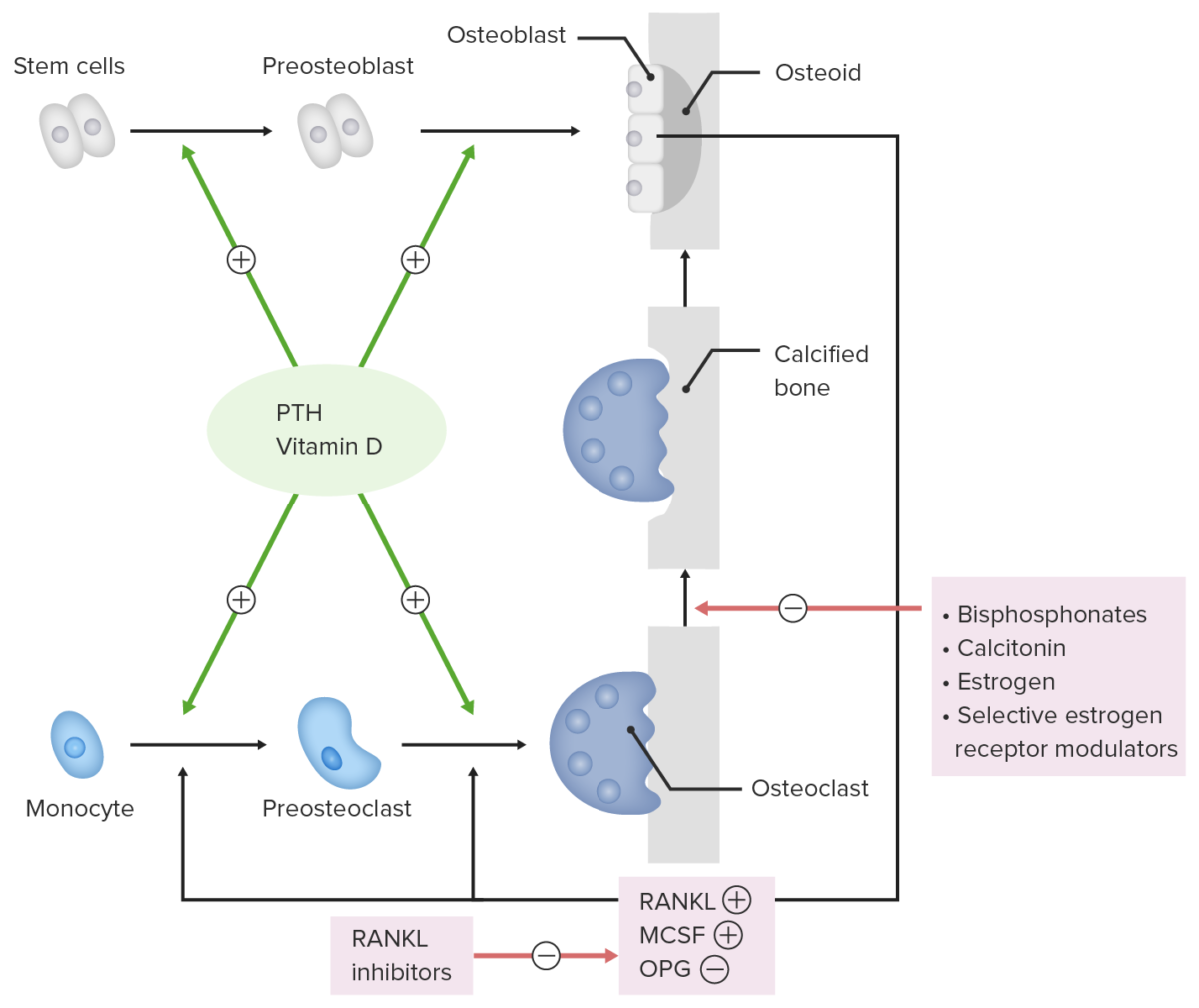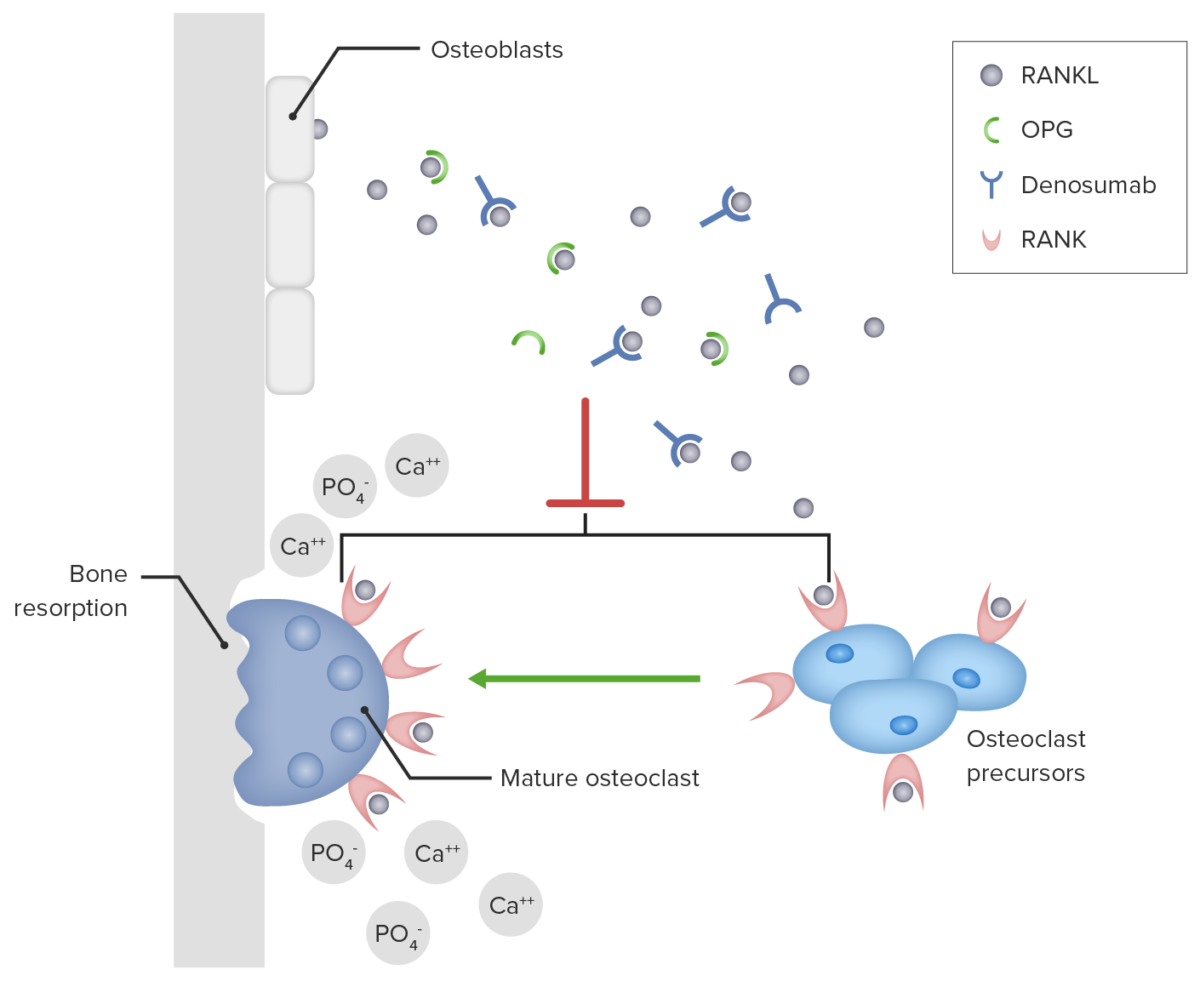Antiresorptive drugs are used to treat osteoporosis Osteoporosis Osteoporosis refers to a decrease in bone mass and density leading to an increased number of fractures. There are 2 forms of osteoporosis: primary, which is commonly postmenopausal or senile; and secondary, which is a manifestation of immobilization, underlying medical disorders, or long-term use of certain medications. Osteoporosis. Bisphosphonates Bisphosphonates Bisphosphonates are pyrophosphate analogs most well-known for treating osteoporosis by preventing bone loss. Bisphosphonates end in the suffix "-dronate" or "-dronic acid" (e.g., alendronate, risedronate, pamidronate) and bind to hydroxyapatite crystals in bone, inhibiting osteoclast-induced bone resorption. Bisphosphonates are generally used as 1st-line therapy, but other options are available for individuals who fail or cannot tolerate therapy. The drug classes include exogenous hormone therapy (teriparatide, calcitonin, estrogen Estrogen Compounds that interact with estrogen receptors in target tissues to bring about the effects similar to those of estradiol. Estrogens stimulate the female reproductive organs, and the development of secondary female sex characteristics. Estrogenic chemicals include natural, synthetic, steroidal, or non-steroidal compounds. Ovaries: Anatomy, and vitamin D Vitamin D A vitamin that includes both cholecalciferols and ergocalciferols, which have the common effect of preventing or curing rickets in animals. It can also be viewed as a hormone since it can be formed in skin by action of ultraviolet rays upon the precursors, 7-dehydrocholesterol and ergosterol, and acts on vitamin D receptors to regulate calcium in opposition to parathyroid hormone. Fat-soluble Vitamins and their Deficiencies), selective estrogen Estrogen Compounds that interact with estrogen receptors in target tissues to bring about the effects similar to those of estradiol. Estrogens stimulate the female reproductive organs, and the development of secondary female sex characteristics. Estrogenic chemicals include natural, synthetic, steroidal, or non-steroidal compounds. Ovaries: Anatomy receptor Receptor Receptors are proteins located either on the surface of or within a cell that can bind to signaling molecules known as ligands (e.g., hormones) and cause some type of response within the cell. Receptors modulators, and RANKL RANKL A tumor necrosis factor receptor family member that is specific for rank ligand and plays a role in bone homeostasis by regulating osteoclastogenesis. It is also expressed on dendritic cells where it plays a role in regulating dendritic cell survival. Signaling by the activated receptor occurs through its association with tnf receptor-associated factors. Paget Disease of Bone inhibitors. Most of these drugs inhibit osteoclast activity to decrease bone resorption Bone resorption Bone loss due to osteoclastic activity. Bones: Remodeling and Healing. A notable exception is teriparatide, which stimulates osteoblast activity to promote bone Bone Bone is a compact type of hardened connective tissue composed of bone cells, membranes, an extracellular mineralized matrix, and central bone marrow. The 2 primary types of bone are compact and spongy. Bones: Structure and Types formation. Adverse effects vary greatly among drug classes.
Last updated: Nov 10, 2022
Osteoporosis Osteoporosis Osteoporosis refers to a decrease in bone mass and density leading to an increased number of fractures. There are 2 forms of osteoporosis: primary, which is commonly postmenopausal or senile; and secondary, which is a manifestation of immobilization, underlying medical disorders, or long-term use of certain medications. Osteoporosis is a skeletal disorder caused by the deterioration of bone Bone Bone is a compact type of hardened connective tissue composed of bone cells, membranes, an extracellular mineralized matrix, and central bone marrow. The 2 primary types of bone are compact and spongy. Bones: Structure and Types tissue, which leads to bone Bone Bone is a compact type of hardened connective tissue composed of bone cells, membranes, an extracellular mineralized matrix, and central bone marrow. The 2 primary types of bone are compact and spongy. Bones: Structure and Types fragility. Antiresorptive medications are often used in the treatment of osteoporosis Osteoporosis Osteoporosis refers to a decrease in bone mass and density leading to an increased number of fractures. There are 2 forms of osteoporosis: primary, which is commonly postmenopausal or senile; and secondary, which is a manifestation of immobilization, underlying medical disorders, or long-term use of certain medications. Osteoporosis to prevent disease progression.

Mechanisms of action for various osteoporosis therapies
OPG: osteoprotegerin
MCSF: macrophage colony-stimulating factor
Teriparatide:
Calcitonin:
Teriparatide:
Calcitonin:
Teriparatide:
Calcitonin:
Teriparatide:
Calcitonin:
The pharmacokinetics Pharmacokinetics Pharmacokinetics is the science that analyzes how the human body interacts with a drug. Pharmacokinetics examines how the drug is absorbed, distributed, metabolized, and excreted by the body. Pharmacokinetics and Pharmacodynamics of raloxifene are as follows:
The following adverse effects are associated with raloxifene use:
Denosumab is the only medication in the RANKL RANKL A tumor necrosis factor receptor family member that is specific for rank ligand and plays a role in bone homeostasis by regulating osteoclastogenesis. It is also expressed on dendritic cells where it plays a role in regulating dendritic cell survival. Signaling by the activated receptor occurs through its association with tnf receptor-associated factors. Paget Disease of Bone inhibitor drug class.

Mechanism of action for the receptor activator of the RANKL inhibitor, denosumab:
The monoclonal antibody binds to RANKL, preventing its binding to receptor activator of nuclear factor kappa-B (RANK) on preosteoclasts. Osteoclast formation and function is inhibited. Notice that osteoprotegerin (OPG) has a similar function in the bone regulation process.
The table below compares the mechanisms of action and adverse effects of drug classes used to manage and/or prevent osteoporosis Osteoporosis Osteoporosis refers to a decrease in bone mass and density leading to an increased number of fractures. There are 2 forms of osteoporosis: primary, which is commonly postmenopausal or senile; and secondary, which is a manifestation of immobilization, underlying medical disorders, or long-term use of certain medications. Osteoporosis:
| Drug class | Mechanism of action | Adverse effects | |
|---|---|---|---|
| Bisphosphonates Bisphosphonates Bisphosphonates are pyrophosphate analogs most well-known for treating osteoporosis by preventing bone loss. Bisphosphonates end in the suffix “-dronate” or “-dronic acid” (e.g., alendronate, risedronate, pamidronate) and bind to hydroxyapatite crystals in bone, inhibiting osteoclast-induced bone resorption. Bisphosphonates |
|
|
|
| Hormones Hormones Hormones are messenger molecules that are synthesized in one part of the body and move through the bloodstream to exert specific regulatory effects on another part of the body. Hormones play critical roles in coordinating cellular activities throughout the body in response to the constant changes in both the internal and external environments. Hormones: Overview and Types | Teriparatide |
|
|
| Calcitonin |
|
|
|
| Vitamin D Vitamin D A vitamin that includes both cholecalciferols and ergocalciferols, which have the common effect of preventing or curing rickets in animals. It can also be viewed as a hormone since it can be formed in skin by action of ultraviolet rays upon the precursors, 7-dehydrocholesterol and ergosterol, and acts on vitamin D receptors to regulate calcium in opposition to parathyroid hormone. Fat-soluble Vitamins and their Deficiencies3 ( cholecalciferol Cholecalciferol Derivative of 7-dehydroxycholesterol formed by ultraviolet rays breaking of the c9-c10 bond. It differs from ergocalciferol in having a single bond between C22 and C23 and lacking a methyl group at C24. Calcium Hemostasis and Bone Metabolism) |
|
|
|
| Estrogen Estrogen Compounds that interact with estrogen receptors in target tissues to bring about the effects similar to those of estradiol. Estrogens stimulate the female reproductive organs, and the development of secondary female sex characteristics. Estrogenic chemicals include natural, synthetic, steroidal, or non-steroidal compounds. Ovaries: Anatomy |
|
|
|
| Selective estrogen Estrogen Compounds that interact with estrogen receptors in target tissues to bring about the effects similar to those of estradiol. Estrogens stimulate the female reproductive organs, and the development of secondary female sex characteristics. Estrogenic chemicals include natural, synthetic, steroidal, or non-steroidal compounds. Ovaries: Anatomy receptor Receptor Receptors are proteins located either on the surface of or within a cell that can bind to signaling molecules known as ligands (e.g., hormones) and cause some type of response within the cell. Receptors modulators |
|
|
|
| RANKL RANKL A tumor necrosis factor receptor family member that is specific for rank ligand and plays a role in bone homeostasis by regulating osteoclastogenesis. It is also expressed on dendritic cells where it plays a role in regulating dendritic cell survival. Signaling by the activated receptor occurs through its association with tnf receptor-associated factors. Paget Disease of Bone inhibitors |
|
|
|